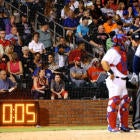When Cactus League and Grapefruit League games begin next week, a pitch clock will be part of the action, commissioner Rob Manfred confirmed to reporters Sunday evening.
Rob Manfred says there will be a pitch clock in spring training to prepare for the regular season. In spring training, he said, "You will see pitch clocks in those games."
— Jeff Passan (@JeffPassan) February 17, 2019
Manfred added he is undecided about a pitch clock for the 2019 regular season. For now, a pitch clock will be used this spring to help players get used to it in case it is implemented in the regular season. Manfred can unilaterally implement a 20-second pitch clock this year, though he said he hopes to reach an agreement with the MLBPA.
A 20-second pitch clock was implemented at the Double-A and Triple-A levels in 2015. An automatic ball is added to the count each time a pitcher takes too long to begin his delivery. It's unclear what sort of penalties will be used in spring training. It could be pitchers will be given a grace period to adjust and receive only a warning at first.
MLB has implemented several rule changes in recent years in an effort to improve pace of play. Batters are not allowed to leave the batter's box after taking a pitch, and last year teams were limited to six mound visits per game. Here are the year-by-year average time of game numbers (per nine innings):
- 2018: 3 hours
- 2017: 3 hours, 5 minutes
- 2016: 3 hours
- 2015: 2 hours, 56 minutes
- 2014: 3 hours, 2 minutes
No change, for all intents and purposes, Time of game and pace of play are not necessarily the same thing, however. There is a lot of standing around in baseball these days. Cutting down on that is priority, not necessarily reducing the time of game. Long games are great when they're exciting.
In addition to a pitch clock, Manfred can unilaterally reduce the number of available mound visits from six to five this year, and also implement an extra innings tiebreaker rule (i.e. extra innings start with a runner at second) for spring training games and the All-Star Game.






















